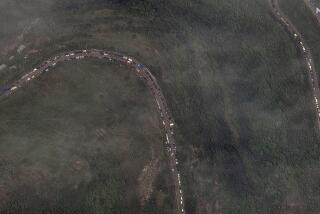Retracing Silk Road of Uzbekistan
- Share via
SAMARKAND, Soviet Union — “You paid much to see our exotics, so don’t complain. You are going to see our exotics.”
Our Intourist guide, Natasha, as dryly humorous as she was dutifully propagandistic, was making light of our aim to see Uzbekistan, the ancient region near Afghanistan and China’s Xinjiang province and now the Uzbek Socialist Soviet Republic.
Natasha, of course, was right. To us, Uzbekistan meant pure exotica.
The very names of the region’s fabled cities--Samarkand, Bukhara and Tashkent--evoke the grandeur of the Silk Road era, a time as rich in intellectual ferment as in East-West trade. After all, the armies of Alexander and Genghis Khan trampled through here. The 14th-Century conqueror, Tamerlane (Timur the Lame) made Samarkand his capital.
Although the basic journey to the Soviet Union still centers on Leningrad, Moscow, Kiev and Tblisi, increasing numbers of Western tourists are making this three-city circuit of Uzbekistan a favorite offbeat trek.
No matter that the great caravans have long since gone and the centuries of decay have laid waste Uzbekistan’s medieval edifices. Along with rampant modernization, enough remnants exist of the old Silk Road to make the trip architecturally and culturally fascinating.
The central areas of Samarkand, Bukhara and especially the region’s largest city, Tashkent (40% of the city was rebuilt after a 1966 earthquake), are examples of urban renewal on the most grandiose of scales, sprawling showplaces of modern architecture in the ponderous Soviet manner.
The well-run subway in Tashkent boasts ornately designed corridors that rival the overwhelming lavishness of Moscow’s and Leningrad’s subterranean stations.
We had little respite from the unrelenting promotion of Uzbekistan’s new economic might. We were repeatedly taken to exhibits of the latest industrial achievements in textile, mining and energy resources, as well as to pictorial displays on how the Soviet Union won World War II virtually single-handed.
The hotels we stayed at were comfortably modern high-rise structures, all outfitted with the basic tourist trappings, including rock-style music and exclusive souvenir and snack shops (which trade only in U.S. dollars or other “hard” currency and are off-limits to Soviet citizens).
This kind of modernization also results in striking cultural clashes:
--Tiny brick, tile-roofed, pre-Socialist dwellings are left in a few central-sector clusters or in the numerous outlying neighborhoods. But many of them sport such modern attachments as carports and TV antennas.
--The bazaars still sell tapestries, carpets, spices, fruits, poultry, pastries and other centuries-old wares. But vendors also sell radios, stereos, jogging suits and Pepsi-Cola.
--The people, whose faces display a diverse ethnic mix, still wear traditional robes and colorful silk dresses. Many wear embroidered skullcaps. Some nomadic visitors still favor the heavily padded jackets, shaggy fur hats and boots that are said to insulate them from the 100-degree-plus desert heat.
But there is also an unmistakable trend in Western-imported stylishness, everything from designer jeans to contemporary coiffures.
--Tourists are treated to folk dance programs that are billed as authentic ethnic offerings but seem only to attract other tourists. On our tour, aside from the charmingly Mongolian-flavored circus, the other theatrical attractions were all European rooted, such as the operas “Pagliacci” and “Peter the Great.”
Don’t despair, though. Enough remnants exist of the ancient splendors of Central Asia. To help promote Socialist togetherness in the non-Russian regions, the Soviet Union has sought to preserve or restore certain landmarks of Uzbekistan, a region populated mostly by Uzbeks and Turks but including resettled Russians and Ukrainians.
Most dramatic of all, some of the Islamic faith’s most splendid and largest mosques, mausoleums, minarets and madrasahs (universities) are still standing in Samarkand and Bukhara.
In seeming contradiction to the anti-religious stance of communism is the Soviet state’s annual allocation of millions of rubles for the restoration of such Islamic edifices, a process begun at Lenin’s initiative.
Although many of these religious structures are only aged, ghostly shells, they have not lost their power to evoke high historical and architectural drama. Outside, the arches have a soaring majesty, and the domes and minarets gleam with turquoise, blue- and gold-hued mosaics of glazed tile and terra-cotta. Inside, the walls are covered with faded frescoes and Koranic writings, the atmosphere one of refuge and serenity.
A key monument founded by Ulugbek (Tamerlane’s grandson) is the restored observatory in Samarkand. It was the largest astronomical structure of the Middle Ages and a reminder that Uzbekistan was then one of the world’s scientific meccas.
For us, it was Bukhara’s old town where the 20th Century seemed most blocked out, the Silk Road era most alive.
Still being used are the medieval merchant domes built over Bukhara’s main trade route. The dark but cool cubicles still house such traditional businesses as cobblers, carvers of wood and alabaster, silk peddlers and booksellers.
Along a nearby street, used by an occasional car or truck, is a bathhouse, an elementary school and the inevitable cluster of mosques and madrasahs. At a large park with a pond, men loll in the shade, resting on cushions on low carpeted platforms, playing chess and sipping hot tea from Oriental bowls.
These are the scenes of quietude and timelessness, a brush with the last glories of the old Silk Road.
More to Read
Sign up for The Wild
We’ll help you find the best places to hike, bike and run, as well as the perfect silent spots for meditation and yoga.
You may occasionally receive promotional content from the Los Angeles Times.






